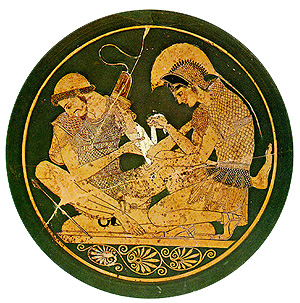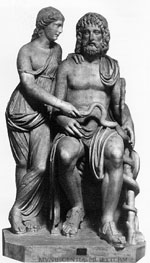Red figure, Attic Cup, c. 490 BCE


Red figure, Attic Cup, c. 490 BCE |
THE PHYSICIAN AT WORKIllustrations of physicians at work are rare in Greek art. This scene, on the inside of a dish dating about 490 BCE, depicting Achilles binding a wound on Patroklos’ arm, exemplifies two apparent aspects of the prevalent formality in patient treatment: a prescribed kneeling position for particular tasks and an overall calmness of manner. Although the episode portrayed here belongs to the mythical Trojan cycle, it is unknown to the extant literature. Ancient mythographers do tell us, however, that Achilles was trained in medicine by Chiron the centaur-sage. Although Achilles was invincible in battle, he is shown here as an inept medic. He is attempting to make a criss-cross tourniquet which will be at once comfortable and capable of staunching the wound. However, his technique is unsuccessful. To judge from Patroklos’ wince, the tourniquet is painful and inexpertly applied because the two ends will not meet. His work will have to be unraveled and redone. |
| Snakes are familiar symbols of healing to modern medical personnel because of their presence on the medical caduceus. The medical caduceus has its origins in WWII, when medics used it as a symbol for a flag of truce. But its association with medicine goes back even further than that to ancient Greece where the snake entwined upon a walking staff was one of the accoutrements of the healer-god Asclepius. The Asclepian staff has often been confused with the caduceus, the herald’s wand used by Hermes. Both were probably symbols of truce in war-time, but the Asclepian staff entwined by only one snake is regarded by Classicists as the true symbol of the profession. | 
Detail, Pompeiian wall painting, first century BCE |
Roman Marble Statue, 1st Century CE |
The snake has been a symbol of healing since prehistoric times. It was
associated with regeneration (due to the easily observable phenomena of it
shedding its skin) and hence of cure itself. The god Asclepius, shown at
left, often appears accompanied by one or more serpents because they were
used in the healing rites at his temples. Snakes were used not only as
part of the Asklepiad cult in Greece, but also in Italy as part of the
private worship within families. Each household contained a shrine, or
lararium, where offerings to the familial ancestors were placed.
|
